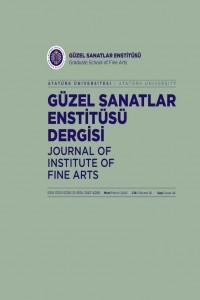Uzak Doğu Seramik Sırlarından Temmoku
Temmoku sırlar yüksek sıcaklıklarda gelişebilen, demir oranı yüksek, yüzeylerinde benekler ya da çizgiler barındıran, rengi açık kahverengiden koyu kahverengi ve siyaha kadar değişen sır grubunu oluşturmaktadır. Geçmişten günümüze kadar varlığını sürdürmeyi başarmış olan bu özel sırlar günümüzde de sanatçıların eserlerinde kullanmayı tercih ettikleri bir sır çeşidi olmuştur. Bu çalışmanın amacı Uzakdoğu seramik sırlarından Temmoku’nun tarihsel süreç içerisindeki gelişimini incelemek, demir oranı yüksek olan bu sırların seramikte temel olarak kullanılan hammaddeler ile günümüz koşullarında elde edilebilirliğini araştırmaktır. Araştırmada öncelikle konu ile ilgili literatür taraması yapılmış; bulunan veriler doğrultusunda deneysel yöntem kullanılarak feldispat, kaolen, kuvars, mermer, dolomit, çinko oksit, soda, magnezit gibi temel hammaddelerden oluşan alkali içerikli sırlar hazırlanmıştır. Renklendirme için %6-13 aralığında demir oksit ilavesi yapılarak öğütme işlemi gerçekleştirilmiştir. Hazırlanan sır karışımları porselen bünyelere uygulanarak 1200°C’ de elektirikli fırında nötr ortamda pişirilmiştir. Çalışmanın sonucunda ise farklı yüzey özelliklerine sahip demirce zengin sırlardan örnekler sunularak çalışma desteklenmiştir.
Anahtar Kelimeler:
seramik, seramik sırları, temmoku, yağ benekli, tavşan kürkü
Temmoku as a Far Eastern Ceramic Glaze
Temmoku glazes are formed from light brown to dark brown and black glaze groups, which can develop at high temperatures, have high iron content and have spots or streaks on their surfaces. These special glazes, which have survived from the past to the present, have been a kind of secret that artists prefer to use in their works. The aim of this study is to examine the development of Temmoku glazes, one of the most special glazes of the Far East ceramic glazes, in the historical process, and to research the availability of these glazes with high iron content with raw materials in our country in today’s conditions. In the research, firstly literature review was done; In accordance with the data obtained, alkali-containing glazes consisting of basic raw materials such as feldspar, kaolin, quartz, marble, dolomite, zinc oxide, soda, magnesite were prepared. Grinding was carried out by adding iron oxide in the range of 6-13% for coloring. Prepared glaze mixtures were applied to porcelain bodies and baked in 1200 ° C electric oven in neutral environment. As a result of the study, examples of iron-rich glazes with different surface properties were presented and supported.
Keywords:
Ceramics, Ceramic glazes, Temmoku, Oil spot, Hare’s fur,
___
- Britt, J. (2007). The complete guide to high-fire glazes. New York: Lark Crafts An Imprint of Sterling Publishing Co., Inc.
- Genç, S. (2013). Artistik seramik sırları. İstanbul: Boyut Matbaacılık A.Ş.
- Öney, D. (2009). Uzakdoğu sırlarından Temmoku'nun araştırılması ve sır uygulamaları (Yüksek Lisans Tezi). Dokuz Eylül Üniversitesi, İzmir. YÖK tez veri tabanından erişildi (Tez No. 236064).
- Sentance, B. (2004). Ceramics, a world guide to traditional techniques. London: Thames&Hudson Ltd.
- Sutherland, B. (2005). Glazes from natural sources. London: University of Pennsylvania Press.
- Taçyıldız, E. (2018). Seramik sırının sırrı. İstanbul: Hayalperest Yayınevi.
- Tichane, R. (1998). Ash glazes. USA: Krause Publications.
- Vainker, S. (2005). Chinese pottery and porcelain. London: The British Museum Press.
- Virgin, L. E. (2008). Chinese art treasures on display: Later Jades and Ceramics At The Worcester Art Museum. U.S.A: Worcester Art Museum.
- Waal, E. D. (2015). The pot book. China: Phaidon Press Limited.
- Wood, N. (1999). Chinese glazes, their origins, chemistry and recreation. London: A&C Black, University of Pennsylvania Press.
- Görsel 1. (12-13. yüzyıl), Temmoku sırlı vazo, Kaynak: Vainker, S. (2005). Chinese pottery and porcelain. London: The British Museum Press. (s.90)
- Görsel 2. (12-13. yüzyıl), Yaprak dekorlu çay kasesi, Herbert ve Eunice Shatzman koleksiyonu, Ackland Sanat Müzesi. Kaynak: Britt, J. (2007). The complete guide to high-fire glazes. New York: Lark Crafts An Imprint of Sterling Publishing Co., Inc.(s.76)
- Görsel 3. (12-13. yüzyıl), Hare’s fur kap, Herbert and Eunice Shatzman koleksiyonu, Ackland Sanat Müzesi. Kaynak: Britt, J. (2007). The complete guide to high-fire glazes. New York: Lark Crafts An Imprint of Sterling Publishing Co., Inc.(s.73)
- Görsel 4. (12-13.yüzyıl), Jian tipi Hare’s fur kâse, Kaynak: Vainker, S. (2005). Chinese pottery and porcelain. London: The British Museum Press.(s.121)
- Görsel 5. (960-1279), Song Hanedanlığı, Çin, Kaynak: Waal, E. D. (2015). The pot book. China: Phaidon Press Limited.(s.123)
- Görsel 6. Sırların tartım, öğütme ve uygulama aşaması. Pınar Çalışkan Güneş şahsi arşivi.
- ISSN: 1300-9206
- Yayın Aralığı: Aylık
- Yayıncı: Atatürk Üniversitesi
Sayıdaki Diğer Makaleler
Uzak Doğu Seramik Sırlarından Temmoku
Televizyon Reklamlarına Göstergebilimsel Bir Yaklaşım Kent Şekerleme Reklamı
Çağdaş Sanatta Yazı Seramik Malzemenin Plastik Dili Üzerinden Bir Değerlendirme
Nuh AKMEHMEDOĞLU, Özgür Sadık KARATAŞ
Yalvaç Yöresi Heybe Dokumaları
Hamam Kültürü Ve Seramik Yansımaları
Resim İş Öğretmenliği Lisans Derslerinin Meslek Hayatına Katkısına Yönelik Öğretmen Görüşleri
Erzincan’dan Tek Nefli İki Kilise: Değirmenliköy ve Yaylabaşı Kiliseleri
Türk Halı Sanatı Kompozisyonlarında Hayat ve Zaman Kavramları
